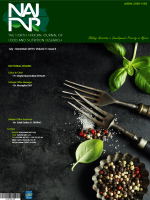Main Article Content
Acceptance of salt reduction in bakery bread among Moroccan consumers
Abstract
Background: The use of cooking salt (sodium chloride) for bread preparation is due to several important sensory and technological properties. Even considered as an essential micronutrient and a salty taste stimulus, a significant dietary sodium intake is positively correlated with high blood pressure levels and some heart diseases. Recently, Morocco has adopted a plan to reduce salt consumption aiming to reinforce the prevention of Non-Communicable Diseases (NCDs) and to contribute to the achievement of 2025 global voluntary targets, set by the Second International Conference on Nutrition (ICN2).
Aims: The aim of the present study was to determine the acceptance of bakery bread with a different percentage reduction of salt bythe Moroccan population.
Subjects and Methods: Various percentages of salt reduction in experimental bread; 7%, 10%, 16%, 23%, 30%, and 53%, were tasted and compared with standard market bread by 201 individuals. “Just About Right” (JAR) and purchase scales were utilized to score the different sample bread.
Results: Bread with 10% and 16% salt reduction were highly accepted by 76% and 79% of tasters, respectively. Based on the JAR score, these types of bread were considered as “just about right’ by 50% and 57% of the participants respectively. The best average score of purchase intent was obtained for salt content of 1.62g and 1.56g per 100g for a reduction of 10% and 16% respectively.
Conclusions: The current adopted strategy allows a 16% sodium reduction while maintaining taste quality.







